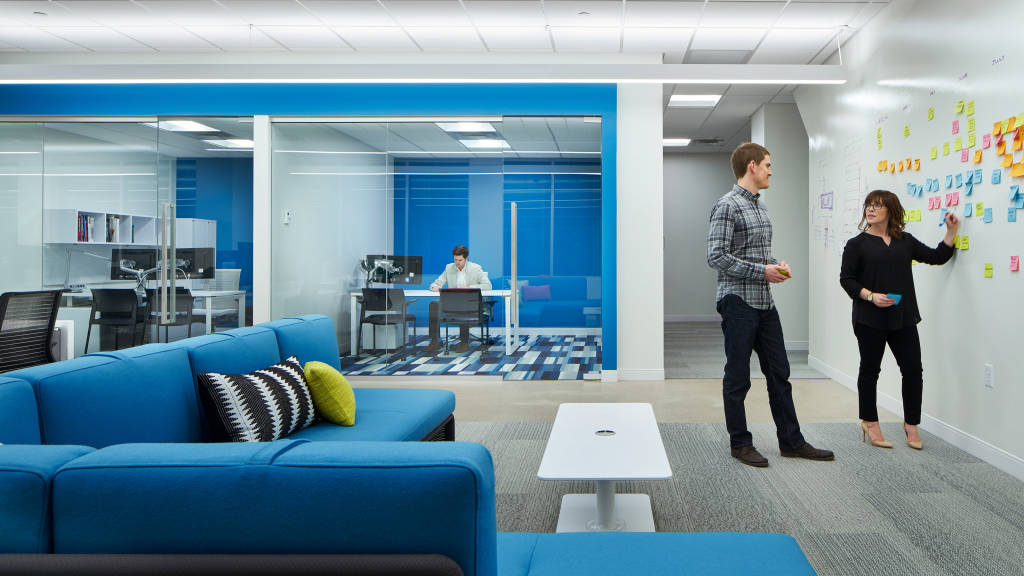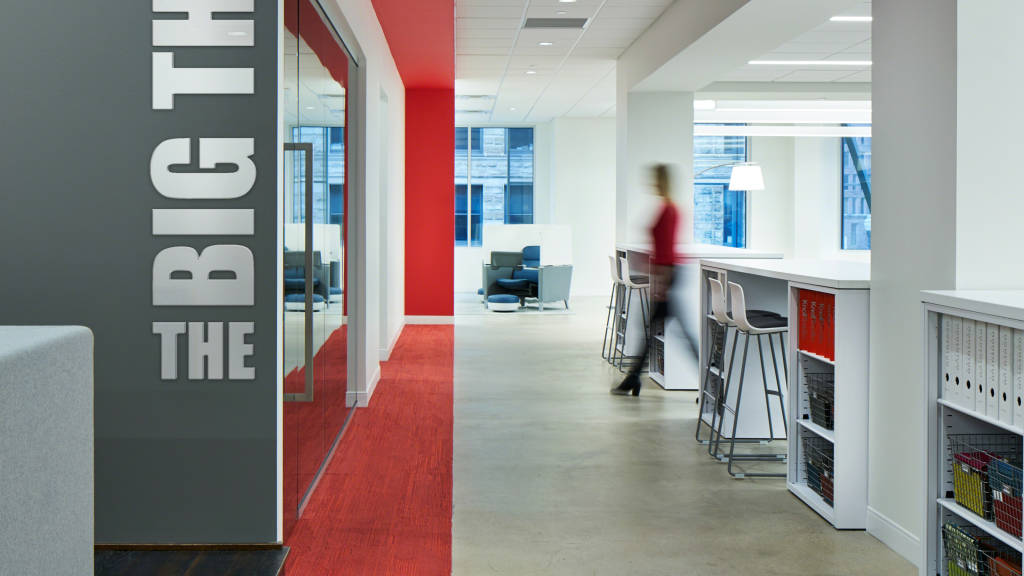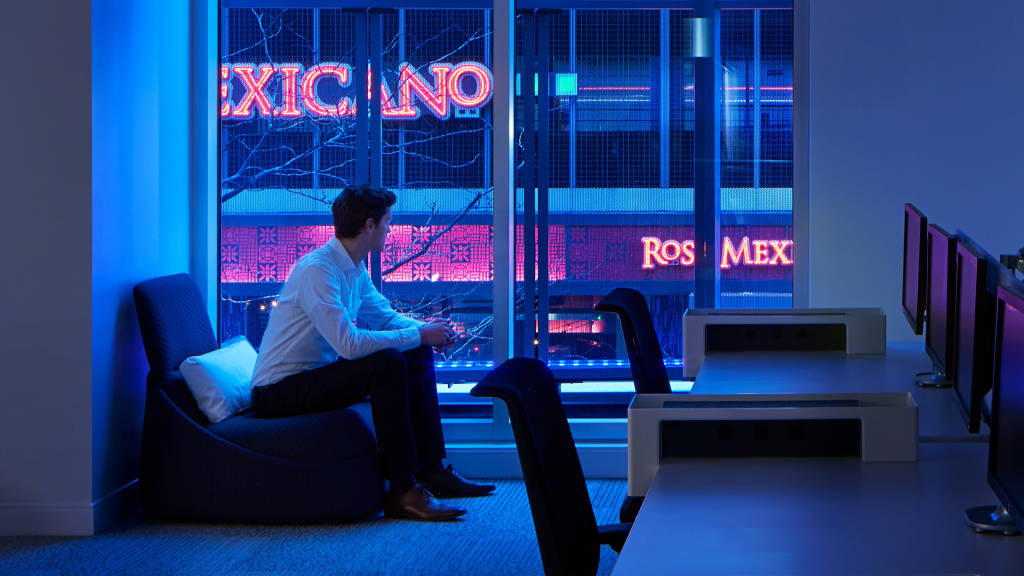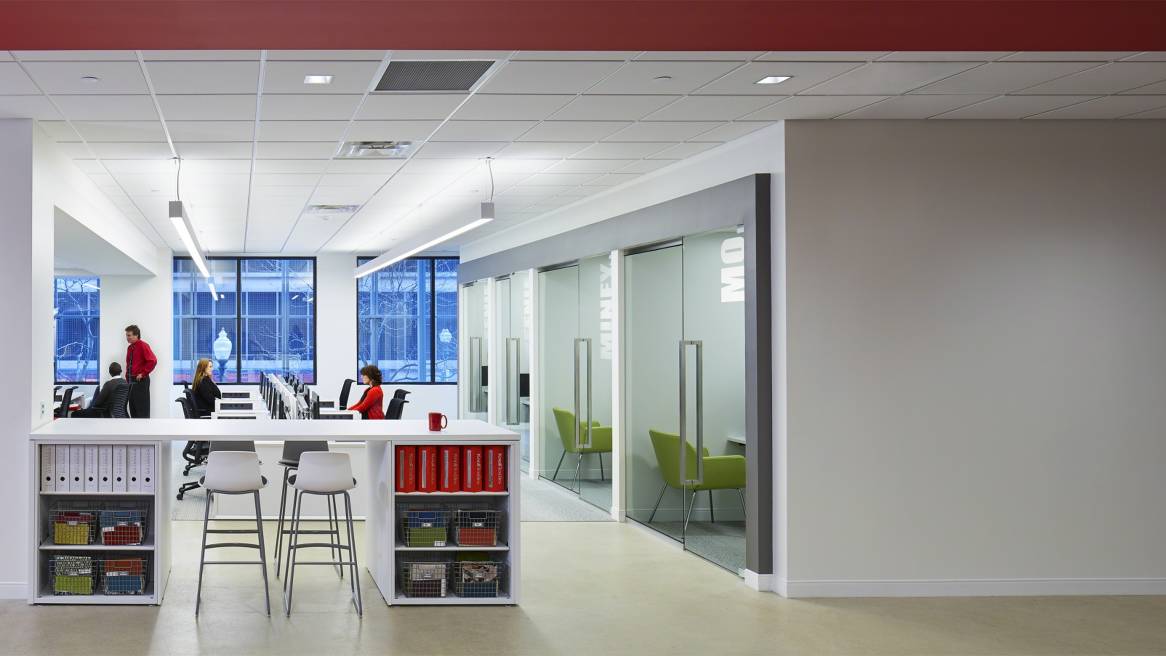HDR
ARCHITECTURE FIRM’S NEW OFFICE BLENDS COFFEE SHOP VIBE WITH DESIGN STUDIO
For many years, architects and designers in the St. Paul, Minn. architecture office of HDR, the global engineering and architecture firm, told clients that the workplace of the future would feature open collaboration spaces designed to support an increasingly mobile workforce.
Yet their own office was hardly a model of that vision. There was little support for mobile work. Employees were separated into cubicles and enclosed offices, hampering communication and connection. “It was a very regimented way of doing business,” says Jim Thomson, managing principal.
HDR’s situation at the time was not unique. Many employees of professional firms, including architects and designers, worked in similarly enclosed and partitioned offices.
“But if we tell our clients one thing about the workplace and we live a different way, why are we doing this at all? We needed to be the example,” says Thomson.
That set the strategy for HDR’s new downtown Minneapolis office, a diverse ecosystem of unassigned spaces where workers choose where and how they need to work: at a bench workstation or a standing-height table, a lounge setting, a glass-front project room, a cozy Brody® WorkLounge, or another space that suits the work at hand. The space emphasizes employee choice, collaboration and wellbeing.

“It’s a workplace where the atmosphere of a coffee shop meets the design studio.”
Mike RodriguezDesign Principal
Lessons from the Past
This vision is based on architecture offices from the past. When HDR began planning the space, employees were asked to find photos of work environments that represented how they wanted to work. Many selected images of architecture offices from nearly a century ago.
“Architecture firms in the ’20s and ’30s had open offices with a lot of light and life,” says Rodriguez. “Then something happened. Private offices moved in, and firms built all of these enclosed spaces. We decided it was time to go back to the open workplace, only with a modern take.”
The result is apparent even before entering the HDR office, which is located along a downtown Minneapolis skyway. Pedestrians on this public walkway can see into HDR’s office, including the reception area that opens to a standing-height coffee bar and a large team workspace.
“We call it The BIG Think, and it’s a metaphor for the whole office,” says Rodriguez. With full-height whiteboard walls, moveable lounge seating and plenty of elbow room, “it puts interaction, collaboration and the creative process on display. We have brainstorming sessions here, client meetings, project meetings. It’s different every day, even at different times of the day.”

The BIG Think and the adjoining hospitality area, which is about 1,200 square feet, can easily host up to 40 people. “There are no boundaries in this space. It’s big and open, and people feel free to throw out ideas. It represents how we work. There are no boundaries to great ideas,” says Thomson.
A few steps past The BIG Think, a group of bench workstations and four huddle rooms offer employees places for individual and small-group work. Standing-height worksurfaces line the aisle that leads to another open collaboration area, more unassigned bench worksettings and a pair of enclosed meeting rooms.
The wide range of workspaces gives employees the ability to choose where and how to work, supports easy communication with their peers and promotes mobile work.
Spaces for heads down work
Since employees also require privacy for heads down work, confidential discussions and an occasional respite, HDR integrated several privacy options into the work environment. In addition to the four huddle conference rooms, there are four freestanding Brody WorkLounges that offer ergonomic seating, adjustable worksurfaces, access to power and lighting, and seated privacy so users feel separate but still connected to the rest of the space.
“Oh my goodness, we love the Brodys. You can put yourself almost in a cocoon,” says Julie Robertson, senior interior designer.
When any of the HDR principals are out of the office, their private offices are available for use by employees. “They consider their space an extension of our space,” says Robertson.

Robertson herself was leery of not having an assigned workspace. “As an interior designer, I have a lot of projects I work on that require samples that I thought I had to hold onto. But purging before the move was very liberating. It made me realize that I don’t need all of it. Here I have the flexibility to work wherever I need to in order to get the job done, with ample project storage that is accessible by anyone in the office. The positive vibe in this space is amazing. I wouldn’t ever want to go back to assigned workstations.”
Measuring up
Employees’ ability to choose and control their work environment and workstyle helps reduce issues with noise and disruption. Employee surveys have found that in HDR’s former office, noise disrupted work in individual primary workspaces up to 74 percent of the time. In the new space, it has dropped to 45 percent.
Other measures show similar improvements. Just 25 percent of employees felt the former office promoted creativity; now 95 percent feel the new office does.
Only 36 percent of employees felt the former office promoted innovation; now 95 percent say it does. And while 42 percent of the staff said the old space promoted knowledge sharing, now 100 percent say the new office does.
“You can work in a setting that matches your workstyle, mood and task.”
Mike RodriguezDesign Principal
HDR’s Minneapolis employees aren’t the only ones who see the benefits of the new space. “This is the kind of space that engages employees, and engaged employees are more productive. The feedback on surveys has been very positive,” say Beth Amenta, head of facilities and real estate for all HDR offices. “We are walking the talk now -– working in the kind of space that we recommend to our clients.”
“Everyone works differently,” says Rodriguez. “Some think best in groups, others seated alone. Some by a whiteboard they can draw on or next to the coffee pot. If you love coming to work every day because you have the flexibility to work in a setting that matches your work style, mood, and task, everyone benefits: you, the studio, and our clients. It’s a space inspired not only by our own people, but also the research and insights that Sheppard’s and Steelcase have shared about how people work. You can see the results.”
“Our space represents the quality of work we do,” says Thomson. “It supports us and enables us to be better. I think it has heightened our employees’ desire to do great work.”
TRUE DIMENSIONS: HDR’s Minneapolis Architecture Studio
| Total real estate | 7,787 SF |
| Full-time employees | 35 |
| Employees who feel the space promotes creativity and innovation | 95% |
| Expected daily staff occupancy | 64% |
| Height of cubicles in former St. Paul office | 72 inches |
| Number of cubicles in new office | 0 |
| Number of huddle rooms | 4 |
| Total unassigned workstations | 32 |
| Total unassigned seats (lounge, conference, collaboration areas) | 136 |
| Number of lounge work setting seats | 66 |
| Number of private offices | 3 |
| Number of private offices when unoccupied that are available for use by any employee | 3 |
| Number of users who can comfortably meet in The BIG Think | 40 |
| Number of universities that, in its first 90 days, used the space for meetings | 3 |
| HDR offices worldwide | 225 |
| Offices with only unassigned workspaces | 1 |
CREDITS
Architecture and Design: HDR
Dealership: Sheppard’s Business Interiors
PRODUCTS
FrameOne
Series 5 height adjustable desk
Brody WorkLounge
Post & Beam architectural framework
Universal storage
Campfire Big Table
Alight, Bindu, Buoy, Enea Lottus, Hosu, Lagunitas, Think, Together seating
Eyesite monitor arms
Soto Launch Pad
Dash task lighting


